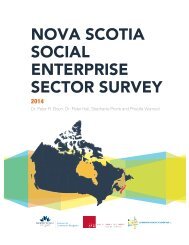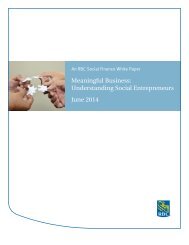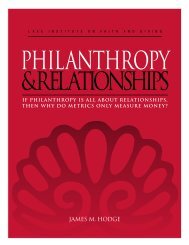Accelerating our Impact: Philanthropy, Innovation and Social Change
Create successful ePaper yourself
Turn your PDF publications into a flip-book with our unique Google optimized e-Paper software.
<strong>Accelerating</strong> <strong>our</strong> <strong>Impact</strong>: <strong>Philanthropy</strong>, <strong>Innovation</strong> <strong>and</strong> <strong>Social</strong> <strong>Change</strong> The J.W. McConnell Family Foundation<br />
Funders can however request a well articulated vision <strong>and</strong> a robust strategy, while<br />
being ready for significant variability as the social change initiative is implemented.<br />
Above all, funders should accept that complex is not synonymous with unmanageable<br />
<strong>and</strong> that there are recognized guidelines that can help maintain a consistent direction<br />
at all stages, from choosing an initiative to measuring results.<br />
Where to invest?<br />
Concepts <strong>and</strong> frameworks help. But of c<strong>our</strong>se there are additional steps. A fundamental<br />
decision for grantmakers interested in innovation <strong>and</strong> social change is<br />
determining what to invest in. A funding strategy should include an assessment<br />
of timing, context, opportunity to achieve results <strong>and</strong> res<strong>our</strong>ce requirements. Grantmakers<br />
may wish to focus on:<br />
• a sector, such as education or health care;<br />
• a specific issue, such as poverty or global warming;<br />
• a particular community or region;<br />
• a demographic, such as youth or seniors or new immigrants;<br />
• or a mix of the above.<br />
More specific criteria <strong>and</strong> considerations are presented in section two of this paper.<br />
Two key points are relevant here. First, successful grantmaking begins with clear<br />
alignment between the funding organization’s m<strong>and</strong>ate, values, <strong>and</strong> experience <strong>and</strong><br />
those of the initiative <strong>and</strong> the people behind it. Second, it is not necessary to be a<br />
large grantmaker with major geographic reach to influence change. Deep change<br />
processes often begin at the local level, <strong>and</strong> in any case must be rooted there if they<br />
are to last.<br />
What is the potential impact?<br />
Criteria or guiding questions can include the following:<br />
• What social challenge is this innovation intended to address?<br />
• How does it propose to have a significant impact on this challenge,<br />
whether it is reducing child poverty, improving educational performance,<br />
or preserving bio-diversity?<br />
• Do we know what others are doing in this area? Is there potential<br />
for a collaborative approach? (see for example the Ashoka Foundation’s<br />
<strong>Change</strong>makers site 13 )<br />
• What demonstrated level of dem<strong>and</strong> exists for a fresh approach<br />
to what is likely a chronic problem?<br />
• If the innovation is local, has it been tested in a new site<br />
<strong>and</strong> does it appear adaptable to varying conditions?<br />
• Is the policy environment (local/provincial/federal) receptive <strong>and</strong> capable<br />
of supporting or integrating the innovation? Is there actual or potential<br />
public support?<br />
• Is the innovating organization both vigorous <strong>and</strong> flexible enough to undertake<br />
the complex process of growth (if that is part of their strategy) with a social<br />
change agenda?<br />
• Are the innovation’s values clearly expressed? Ultimately, social innovations<br />
result in lasting change only when they are clearly <strong>and</strong> explicitly wedded to values<br />
that inspire others. These values include social justice, compassion, trust,<br />
reciprocity, hospitality, <strong>and</strong> so on.<br />
22<br />
11 Margaret Wheatley is a writer <strong>and</strong> management consultant who studies organizational behavior.<br />
Her approach includes systems thinking, theories of change, chaos theory, leadership <strong>and</strong> the learning<br />
organization: particularly its capacity to self-organize.<br />
12 Zimmerman, Lindberg <strong>and</strong> Plsek, 1998. Another good overview of complexity theory <strong>and</strong> its implications<br />
for organizations is Margaret Wheatley’s Leadership <strong>and</strong> the New Science: Learning about Organization from<br />
an Orderly Universe, (1st edition), Berrett-Koehler: 1992.<br />
13 <strong>Change</strong>makers website < http://www.changemakers.net > .<br />
23







